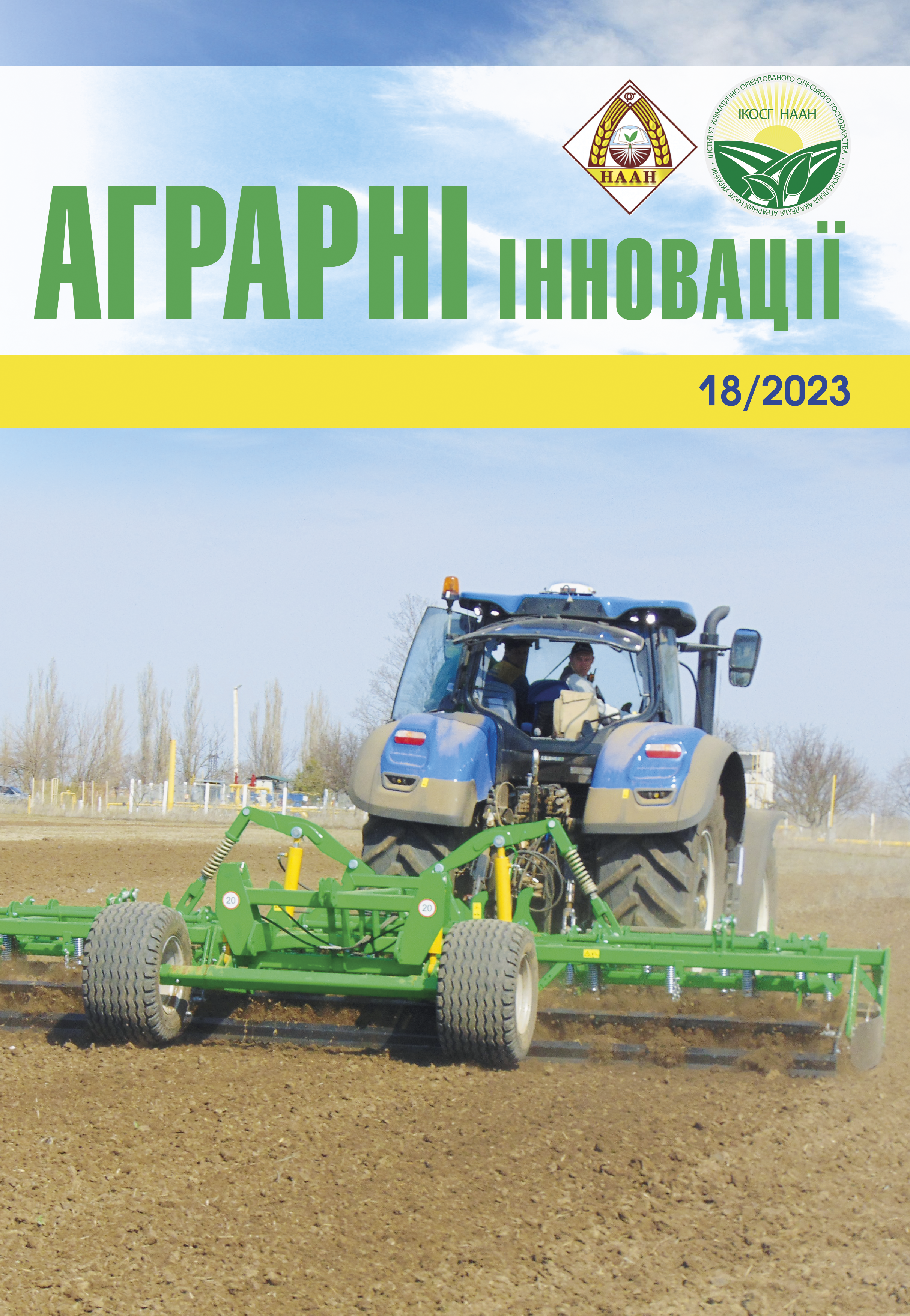THE EFFECT OF PRE-SOWING TREATMENT OF SEEDS WITH BIOLOGICAL PREPARATIONS ON THE GROWTH AND DEVELOPMENT OF PLANTS OF WINTER WHEAT VARIETIES
Abstract
The goal is to establish the influence of varietal characteristics and pre-sowing treatment of seeds with biological preparations on the growth and development of winter wheat plants when grown in the conditions of Southern Ukraine. Methods. Experimental research was carried out during 2020–2022 at the research field of the Educational-Scientific-Practical Center of Mykolaiv NAU. The research material was 10 varieties of soft winter wheat. The technology of their cultivation, with the exception of the investigated factors, was generally accepted according to the existing zonal recommendations for the southern Steppe of Ukraine. The area of the sowing plot is 50 m2, the accounting plot is 26 m2, the repetition is 4 times, the placement of plots by the method of incomplete randomization. The scheme of the experiment included the following options: Factor A – varieties of winter wheat (10 options); Factor B – biological preparations: control (water treatment), Azotophyt-r, Phytocid-r, Azotophyt-r and Phytocid-r. The results. On average, the winter wheat plants in the variant with pre-sowing seed treatment with biological preparations Azotophyt-r and Phytocid-r formed a higher height of winter wheat plants. It was established that the winter wheat varieties Duma Odeska and Rodzynka Odeska had high resistance to lodging – 8–9 points, respectively, and the varieties Khersonska 99 (8,7 points) and Rodzynka Odeska (8,8 points) were more resistant to drought. On average, according to the options of presowing seed treatment, the winter wheat variety Liga Odeska formed a grain yield at the level of 5,66 t/ha, which exceeded the indicators of other researched varieties by 0,9–18,9%. Conclusions. Research has established that the yield of soft winter wheat grain largely depends and varies under the influence of pre-sowing treatment of seeds with biological preparations and varietal characteristics of the crop. Of the bacterial preparations studied by us, the highest yield was formed by the winter wheat variety Liga Odeska with the combined pre-sowing treatment of seeds with biopreparations Azotophyt-r and Phytocid-r, and the lowest – by the variety Versiya Odeska in the control variant.
References
2. Nazarenko M., Mykolenko S., Okhmat P. Variation in grain productivity and quality of modern winter wheat varieties in northern Ukrainian Steppe. Ukrainian Journal of Ecology, 2020. 10(3), Р. 102–108. doi: 10.15421/2020_175
3. Базалій В.В., Бойчук І.В., Лавриненко Ю.В., Базалій Г.Г., Домарацький Є.О., Ларченко О.В. Проблеми та продуктивність селекції сортів озимої пшениці підвищеної екологічності. Фактори експериментальної еволюції організмів, 2019. 24, С. 20–25.
4. Singh G., Sharma G., Sanchita, Kalra P., Batish D.R., Verma V. Role of alkyl silatranes as plant growthregulators: comparative substitution effect on root and shoot development of wheat and maize. Journal of the science of nutrition and agriculture, 2018. 98(13), Р. 5129–5133.
5. Klein J., Guimarães V. F. Evaluation of the agronomic efficiency of liquid and peat inoculants of Azospirillum brasilense strains in wheat culture, associated with nitrogen fertilization. Journal of Nutrition, Agriculture & Environment, 2018. 16 (1), Р. 41–48.
6. Korkhova M., Drobitko А., Panfilova А., Smirnova I. The role of winter wheat plant height in the formation of grain yield depending on varietal characteristics and weather conditions. Scientific Horizons. 2022. 25(11). Р. 41–50.
7. Бондаренко М., Назаренко М. Сорти пшениці французької селекції адаптовані до умов українського Північного Степу. Агрологія, 2020. 3 (4), С. 193–198. 8. Lollato R. P., Ruiz Diaz D. A., De Wolf E., Knapp M., Peterson D. E., Fritz Allan K. Agronomic practices for reducing wheat yield gaps: A quantitative appraisal of progressive producers. Crop Science, 2019. 59 (1), 333.
9. Wu, L., & Zhatova, H. (2022). Study of winter wheat collection for developing initial material with low cd-uptake. Bulletin of Sumy National Agrarian University, 1(47), 3–10.
10. Державний реєстр сортів рослин, придатних до поширення в Україні на 2022 рік. Київ: Мінагрополітики та продовольства України. 2022. URL: https://minagro. gov.ua/file-storage/reyestr-sortiv-roslin (дата звернення: 11.05.2022).
11. Дослідна справа в агрономії : навч. посібник : Статистична обробка результатів агрономічних досліджень / А.О. Рожков, В.К. Пузік, С.М. Каленська та ін.; за ред. А.О. Рожкова. Харків : Майдан, 2016. 342 с.
12. Дисперсійний і кореляційний аналіз у землеробстві та рослинництві : навч. посіб. / В.О. Ушкаренко, В.Л. Нікішенко, С.П. Голобородько, С.В. Коковіхін. Херсон : Айлант 2008. 272 с.
13. Visioli G., Bonas U., Dal Cortivo C., Pasini G., Marmiroli N., Mosca G., Vamerali T. Variations in yield and gluten proteins in durum wheat varieties under lateseason foliar versus soil application of nitrogen fertilizer in a northern Mediterranean environment. Journal of the Science of Food and Agriculture, 2018, 6(98), 360–369.
14. Коваленко О. А., Корхова М. М. Оцінка посухостійкості та добір сортів пшениці озимої (Triticum aestivum L.), придатних до поширення в умовах Миколаївської області. Збірник наукових праць ВНАУ. 2011. № 9 (49). С. 62–73.






